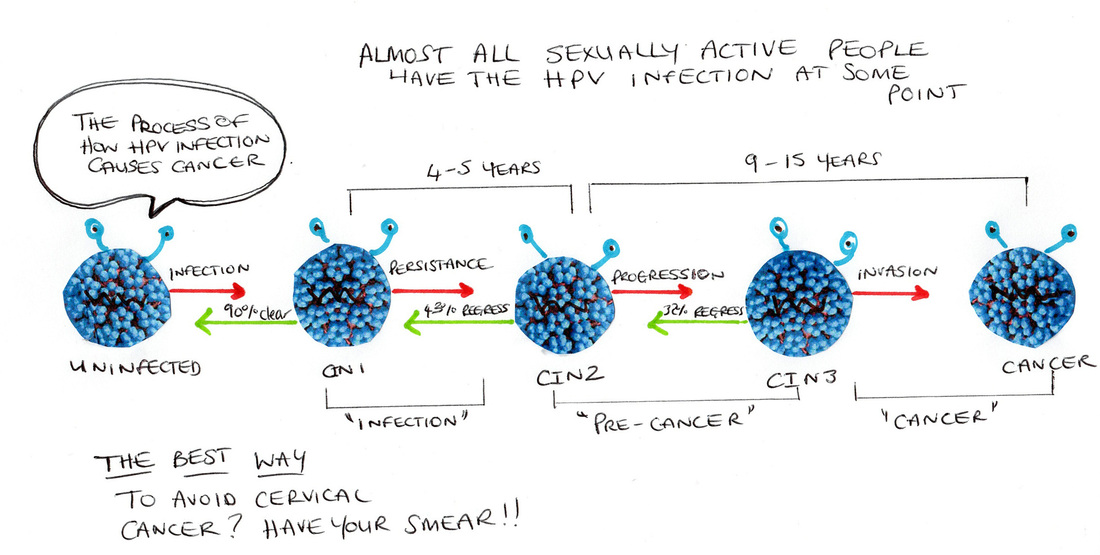 This post is a follow up to the previous Smear (pap) Test one I did. If you've had a smear test come back as abnormal, the following explanation may just answer a lot of your questions regarding what that means. Please do read the previous post which can be found here: http://www.kenttherapyclinic.co.uk/blog/cervical-smear-pap-test-abnormal-results So, you've got the diagnosis of abnormal cervical cells and as I stated all over the last article, because I really want you to listen....that quite possibly means that it's NOT cancer, but abnormalities created as a result of a very common virus called the Human Papillova Virus or HPV for short. YOU SHOULD NOT PANIC if you get a letter saying you have an abnormal smear test or if they state you have low grade or high grade dyskaryosis. In my previous article I talk all about the absolute horror of getting that letter through the post which states any of the above. It can really upset women and make them terrified of the implications. In simple terms; HPV is a sexually transmitted infection. However, before you fear the worst (that your other half has been messing around behind your back!) it's a really common virus effecting almost ALL sexually active men and women at some point in their lives. There's no shame in having it. It can be caught at any part of sexual contact via skin to skin contact. So that means, all types of sexual intercourse including normal, oral and anal sex. It's not choosy, it just likes everyone! It's a little like herpes in as much as it stays within your system for years and can remain dormant. There are over 100 variants of the virus and most are not harmful. Many people contract the virus and don't ever have any side effects. The body fights it off and they never develop any illnesses as a result. Some contact the version that leads to genital warts, and some get the strain that can cause cancer. The type of HPV virus that causes genital warts is not the same as the one that causes cancer. So - what can you do about HPV? Well, as the illustration suggests YOU are the key to not getting cancer of the cervix. Regular smears are the only way to prevent abnormal cells turning into full blown cancer ones. Cell changes are often referred to as Dyskarosis.
And just to reiterate.....anyone who is sexually active can get HPV, even if you have had sex with only one person. In anyone who has had multiple partners, it could have been your first sexual contact, the latest one or any in between. Our children in the UK are now being vaccinated against this virus because almost all kinds of cervical cancer are caused by a strain of HPV. Once you become sexually active, you need to go for your smear tests because by far the best way of never getting cervical cancer is regular screening and treatment if abnormal cells are found! HPV can also cause other cancers including cancer of the vulva, vagina, penis, or anus. It can also cause cancer in the back of the throat, including the base of the tongue and tonsils (calledoropharyngeal cancer). The good news is that HPV cell changes are slow. Really slow. So chances are, if you discover any cell abnormalities, a quick treatment is all you need in order to get rid of them! Below is a very unartistic diagram I drew to show the progression of HPV into cancer. I hope this will settle some nerves and give you some hope that even if you have been diagnosed with abnormalities, as long as they've found them early enough, there should be no reason to think you have cancer. I hope this article and the one before helps some of you. I work with people who have either had, or are currently being diagnosed with cancers of all kinds. Fact is 1 in 4 of us will contract cancer at some point. Being on top of it is the key. Even if you don't have symptoms, DO get your pap smear tests done! Author Emma Evans An easy to understand guide to your pap smear test results (in plain English!!) As part of my job, from time to time I have to support someone who may be facing cancer or is awaiting a cancer diagnosis. With 1 in 4 people getting cancer of some kind during their lives (often perfectly treatable and non-life-threatening) therapists do see a fair share of clients who are recovering or have just been diagnosed. Recently I had experience of a cervical cancer scare. I did a LOT of research for this particular case and I figured that some of the information that I found out may be really helpful for other women who are possibly going through a similar situation. Firstly, when you go for your smear, it may not be the most pleasant experience in the world, but hey, 5 minutes with someone poking about in your insides has got to be better than the horror of a full blown cancer diagnosis. Especially when you consider that almost all cases of abnormal cells found CAN be treated if they are found early enough, as was the case of my recent client. Smear tests (pap smears) really aren’t anything to worry about. So what’s the score with the smear test? Well, let me explain them in simple non-scientific terms. At your smear you’ll be asked to take of your clothing from the waist down, you then lay down on a medical couch, the nurse or doctor will cover you over usually with a towel, and then off they go. They use a speculum, which looks like this:  It’s not as scary as it looks. I always think it looks like a funny duck, but anyway, it’s just an extending tube type device, this is covered with some kind of lubricant & then gently goes inside of your vagina and allows the person doing the smear to have a clear view of the opening of your cervix. It’s important they can see inside so that they can collect cells from the opening of your cervix to check to see that everything is ok. It shouldn’t hurt at all when they put it in, you might feel a little pulling, but that’s about it. Then they use a tiny brush to collect the cells on your cervix. The brush usually looks like this:  The bristles of the brush are soft. The most you will feel is some pressure and an odd feeling – like a scraping or a tickling sensation. Some women report feeling this as a bit of a sore feeling but you’ll be glad to hear, it’s done within seconds! That sample of cells then gets packaged and sent off to a lab for analysis. So, you’ve been for your smear and between a week to 30 days later you should get a letter from the NHS (if you are in a different country this may vary) to say your smear test is clear – which basically means there’s nothing to worry about. If you do not receive your letter from the NHS you MUST – I repeat MUST follow it up with a phone call to your GP. It is not unheard of for these tests to go missing in the process, so if you don’t get a letter – check, check and double check. I cannot stress enough how important it is that you find out the result. Remember my client? She came to me after she had attended her smear. She thought that because she hadn’t heard anything she was ok. Four years on, she went for another smear and this showed a cancerous growth. This is rare – I stress that because it truly is rare to get full blown cancer of the cervix – but it can happen if you don’t get checked regularly enough or don’t get the warning that something is up! Anyway, lets carry on. If your test comes back borderline, this usually means either something went wrong with the test so they need to re do it, or it was not conclusive. In either of those cases you will be advised if you should leave it until the next smear, or you have to go back for another. There are a number of other results that can be daunting at first so I am going to explain them here because so many women are understandably terrified when they see the words “abnormal results”. Abnormal test results quite often DO NOT mean you have cancer. Now, I know that’s easy for me to say and right about now, if you are reading this because you’ve done a search, chances are it’s because you’ve read those dreaded words “abnormal cell changes” or "mild to moderate dyskaryosis". I understand that this has probably put you into a complete tail spin, fearing the worst and you may be feeling dreadful. But let me assure you, abnormal cell changes can just mean that the lab has picked up some variant from “normal” cells and you need further investigation. It also means that you have usually caught them at a time when they are treatable. If these are left untreated then you have a risk of developing cervical cancer. So as you can see, early detection is essential. A few facts:
Ok – so a recap; mild, moderate or severe dyskaryosis can be picked up on your smear test. I repeat to you though lovely lady; this does not necessarily mean you have cancer, so please, take a nice deep breath and try not to panic. No, don’t try not to panic – JUST DON’T PANIC! These cells are almost always treatable! I understand that’s its as scary as hell. I truly do. I’ve seen enough clients who are in a hysterical mess because of that letter. One piece of paper that even states on it somewhere that it doesn’t mean you have cancer – but they still come to me, petrified. The next step after the abnormality letter, is to wait for an appointment to have a colposcopy. A colposcopy is a procedure where someone who is trained in gynaecology and most importantly, cell changes, will have a proper look, probably paint a solution on to your cervix and look for any cell changes. It can be a specialist, a consultant or a specially trained gene nurse who does your colposcopy. This procedure can identify how severe the changes are (how wide spread) and also, by taking a biopsy, the lab can then test to see what kind of cells you’ve got. The cells are classified as: CN1 - mild changes, these cells can often just resolve themselves believe it or not! Sometimes they just go away. But if you have them, chances are they’ll send you on your way, tell you not to worry too much and re-test you with another smear in around 6 months to a year. CN2 & CN3 – moderate to severe changes. In these cases the specialist will probably want to do some treatment. Depending on the surface area or how deep the cells have gone, there are a number of relatively straight forward removal methods. If your doctor or specialist nurse finds an area of abnormal cells, you may have treatment there and then, or they may make you another appointment to have treatment in a few weeks time. Usually a simple procedure can be done called a LLETZ (Large Loop Excision of the Transformation Zone). This means cutting out the area of the cervix where the abnormal cells develop. This sounds much scarier than it is. It is a quick 5 minute procedure that is pretty painless. The transformation zone means the area just inside the cervical canal. LLETZ is the most common treatment used in the UK. It is simple and quick to carry out, works really effectively and can be done under local anaesthetic. They take this sample of your cervix a clear tissue sample for the laboratory to examine. There are quite a few other treatment options, including laser, cold coagulation and cone biopsy, and these can work equally well. Sometimes the doctor or specialist nurse cannot see clearly enough because the abnormal cells go further up into the cervical canal than can be seen with a colposcope. If they cannot see all the cells that are abnormal you may need a cone biopsy. A cone biopsy is a minor operation that you usually have under general anesthetic. You will probably stay in hospital overnight. While you are under anesthetic the doctor cuts out a cone of tissue from your cervix. The cone includes the whole area of the cervical canal where there might be abnormal cells. The cone of tissue is sent to the laboratory for examination under the microscope. In both cases, they are straight forward procedures that may be slightly uncomfortable afterwards, but apart from slight period pains (and not being able to have sex for 4 weeks, or wear tampax) usually you will not get any other negative effects and usually that’s all you will need in order to clear the effected area. Remember; the good news is, even if you have pre-cancerous cells, and even if you have lots of pre cancerous cells, it often STILL doesn’t mean you have cancer. Cancer of the cervix usually takes many years to develop – somewhere between 6 and 10 years in fact. BUT if you don’t go for your smear, you don’t know if there are early changes – so you really must do that – unfortunately the Jade Goody effect has evaporated, with one in four women missing their last cervical cancer screening test! Don’t risk it being you with that awful letter landing on your door mat. Please look out for my next article explaining why cervical cancer develops and explaining HPV. Oh, and if you’ve enjoyed reading this jargon free explanation of abnormal smear test results, please do pass it on. You can share it on social media or email it to your friends. But whatever you do, please make sure YOU are the one who gets checked regularly. Author Emma Evans |
AuthorEmma Evans runs Kent Therapy Clinic and also helps coach other therapists in her spare time when she's not seeing clients at her busy practice. This blog is full of useful articles and interesting facts to do with therapy in general. Please feel free to add your comments to the blog. Archives
September 2023
Categories
All
|
Terms and conditions
Emma Evans, Kent Therapy, Online Therapy, Hypnotherapy, Clinical Hypnotherapy in Medway, Hypnotherapist in Kent, Stop Smoking Kent, Hypnosis ME8 Kent, Phobias, Anxiety, Stress Management, Hypnotherapist Medway, Gillingham, Maidstone, Kent, Chatham, Rochester, Strood, Hoo, Sittingbourne, Counseling, Psychotherapy, Supervision


 RSS Feed
RSS Feed






